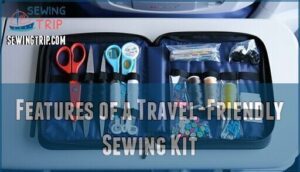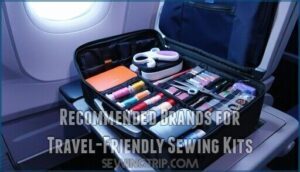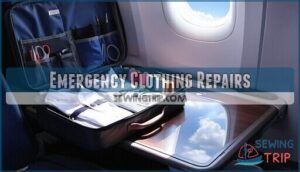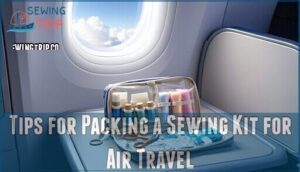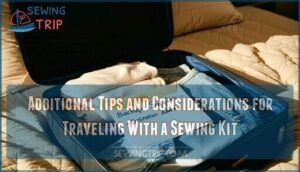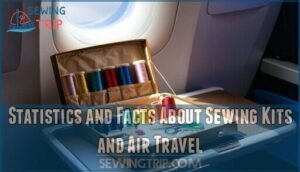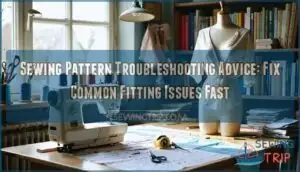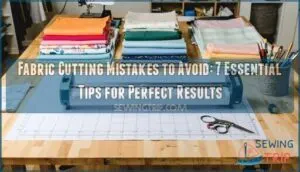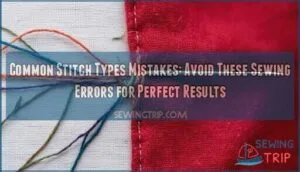This site is supported by our readers. We may earn a commission, at no cost to you, if you purchase through links.
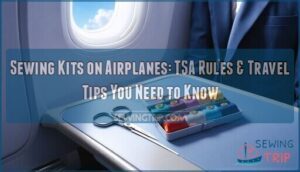 You can bring sewing kits on airplanes in both carry-on and checked bags.
You can bring sewing kits on airplanes in both carry-on and checked bags.
The TSA allows sewing needles, thread, and small scissors under 4 inches from the pivot point in carry-on luggage. Larger scissors must go in checked bags.
Small, blunt-ended needles won’t raise eyebrows at security checkpoints. Pack your kit in a clear organizer to speed through screening.
Think of it as your travel insurance against wardrobe malfunctions – because nothing ruins a business trip quite like a popped button or torn seam. Smart travelers know the right packing techniques can save both time and embarrassment.
Table Of Contents
- Key Takeaways
- TSA Guidelines for Sewing Kits on Airplanes
- Choosing a Travel-Friendly Sewing Kit
- Benefits of Having a Sewing Kit While Traveling
- Tips for Packing a Sewing Kit for Air Travel
- Additional Tips and Considerations for Traveling With a Sewing Kit
- Statistics and Facts About Sewing Kits and Air Travel
- Frequently Asked Questions (FAQs)
- Conclusion
Key Takeaways
- You can bring sewing kits in both carry-on and checked bags, with needles and thread allowed without restrictions
- Keep scissors under 4 inches from the pivot point for carry-on approval – larger scissors must go in checked luggage
- Pack your kit in clear, organized containers to speed through TSA screening and prevent delays at security checkpoints
- You’ll have emergency repair tools for wardrobe malfunctions like popped buttons or torn seams during travel
TSA Guidelines for Sewing Kits on Airplanes
You can bring a sewing kit on planes, but TSA rules determine what items are allowed in carry-on versus checked bags.
Understanding these guidelines helps you pack smart and avoid security delays at the airport.
Carry-on and Checked Bag Guidelines
Understanding TSA guidelines helps you pack your travel sewing kit with confidence.
Most sewing supplies can fly with you in carry-on baggage, but specific rules apply.
Scissors must measure under 4 inches from the pivot point to pass packing security checks.
Needle safety requires secure storage to protect TSA agents during screening.
Liquid restrictions limit sewing machine oil to 3.4 ounces or less.
Prohibited items like rotary cutters belong in checked baggage only.
To avoid issues, remember to check airline-specific regulations.
Following airline regulations prevents confiscation and guarantees smooth security screening for your essential sewing supplies.
TSA-Approved Sewing Items
The TSA allows most sewing kit airplane carryon items, making repairs possible during travel.
Pack your sewing needles and small scissors under 4 inches for hassle-free security screening.
- Needles and thread – All sizes permitted in carry-on bags
- Blunt scissors – Must measure under 4 inches from pivot point
- Liquid adhesives – Limited to 3.4 ounces following TSA regulations
- Needle disposal – Secure sharp items to prevent kit confiscation
Choosing a Travel-Friendly Sewing Kit
When you’re selecting a sewing kit for air travel, you’ll want to focus on compact size and TSA-compliant tools.
Look for kits from trusted brands like Singer or Dritz that include scissors under 4 inches, basic needles, and a variety of thread colors in a clear, organized case, which should have a clear and organized design.
Features of a Travel-Friendly Sewing Kit
Smart travelers know that your travel accessories can make or break your trip.
A compact size sewing kit with essential tools becomes your clothing emergency lifesaver. Look for a durable case protecting a mini sewing kit containing TSA-approved scissors under 4 inches, needle safety features, and thread variety.
Your small sewing kit should include these travel-friendly sewing supplies. Many options are available if you’re seeking a complete travel kit.
| Feature | Why It Matters |
|---|---|
| Compact size | Fits easily in carry-on bags |
| TSA-approved scissors | Passes security without confiscation |
| Needle safety storage | Protects handlers and contents |
| Thread variety | Handles different fabric types |
Recommended Brands for Travel-Friendly Sewing Kits
Several brands deliver excellent travel-friendly sewing kits that meet TSA requirements.
When choosing compact kits, you’ll want options that balance portability with functionality.
Here are top sewing kit brands for air travel:
- Fiskars Travel Sewing Kit – Features TSA-compliant folding scissors and earns 4.4/5 stars from travelers
- Coquimbo Sewing Kit – Offers budget-friendly compact design with essential emergency repair tools
- CraftLab Mini Sewing Kit – Provides durable organization with 12 thread colors in a sturdy case
- JANREAY Sewing Kit – Delivers 94 accessories in a zippered case for extensive travel needs
Singer Kit and Dritz alternatives remain popular choices, though newer compact brands offer premium kits with better organization.
Many kits prioritize a compact and lightweight design for easy transport.
These travel-friendly sewing kits typically cost $6-15 and include everything needed for quick clothing fixes without triggering security concerns.
Benefits of Having a Sewing Kit While Traveling
You’ll find a travel sewing kit incredibly useful when wardrobe mishaps strike during your trip.
Whether you’re dealing with a popped button before an important meeting or need to occupy yourself during a long flight, having the right sewing supplies within reach can save both your outfit and your sanity.
Emergency Clothing Repairs
Nothing ruins a vacation like a wardrobe malfunction. Your travel sewing kit becomes your lifeline when clothing emergencies strike mid-journey.
Rips and tears from luggage handling, button replacements after rushed dressing, and zipper malfunctions can derail your plans. Emergency repairs with needle and thread fix split seams instantly. Button repair takes minutes with the right supplies.
Hem adjustments prevent tripping hazards on unfamiliar terrain. Quick clothing repair saves money and embarrassment. For reliable clothing solutions, consider stocking up on specialized kits.
Your compact kit handles most wardrobe malfunctions before they become disasters.
Sewing During Flights
Beyond quick repairs, sewing kits on airplanes offer relaxation through in-flight projects. However, passenger etiquette matters when sewing while flying. Turbulence sewing poses challenges, so secure your materials properly.
Consider these guidelines for inflight sewing:
- Choose simple projects – Small embroidery or mending work best during flights
- Mind your space – Keep movements minimal to avoid disturbing nearby passengers
- Secure sharp tools – Store needles safely between uses, especially during turbulence
- Plan needle disposal – Bring a small container for used or broken needles
Kit limitations mean complex projects won’t work well in cramped airplane seats. You can even purchase a dedicated airplane sewing kit for your travels.
Tips for Packing a Sewing Kit for Air Travel
When you pack a sewing kit for air travel, you’ll need to follow TSA rules for sharp objects and liquids.
Careful organization and proper storage help you avoid delays at security and keep your tools safe for use during your trip.
Proper Packing Techniques
When packing your sewing kit for air travel, organization prevents headaches at security checkpoints.
Use clear containers for quick TSA inspections and separate compartments for different items.
| Packing Strategy | Benefit |
|---|---|
| Clear plastic pouches | Quick access during screening |
| Foam padding for needles | Damage prevention for sharp tools |
| Labeled compartments | Space saving organization |
| Secure closures | TSA compliance assurance |
| Separate thread storage | Kit organization efficiency |
These sewing kit packing techniques guarantee your supplies stay organized while meeting regulations.
Proper sewing kit packing tips include wrapping scissors in fabric and securing loose items.
Smart packing tips make travel smoother.
Considerations for Sharp Objects
Sharp objects in your sewing kit require careful attention to prevent injuries and TSA complications. Beyond proper packing techniques, you’ll want to focus on needle safety and scissors length requirements.
Pack smart, secure sharp tools, and measure scissors carefully to breeze through airport security.
Here’s how to handle sharp items safely:
- Wrap needles securely – Use magnetic cases or foam padding to prevent punctures
- Measure scissors carefully – TSA allows blades under 4 inches from pivot point
- Avoid rotary cutters completely – These circular blades are banned from carry-on bags
- Pack sharp items centrally – Place them in your bag’s middle, away from sides
- Consider alternatives – Nail clippers work for thread cutting and pass TSA guidelines
TSA guidelines specify that sewing needles are permitted, but packing methods matter. Small scissors under 4 inches can travel in carry-on luggage, while larger cutting tools must go in checked bags. Remember that circular blades and rotary cutters aren’t allowed in carry-on bags regardless of size.
Always verify airline-specific regulations before packing your kit. Smart sewing kit travel means knowing these rules beforehand.
Additional Tips and Considerations for Traveling With a Sewing Kit
Beyond following TSA rules, you’ll want to think about backup plans if your sewing kit gets confiscated or damaged during travel.
Consider mailing expensive items to your destination or getting travel insurance to protect valuable sewing tools and supplies.
Mail Services for Prohibited Items
Airport mail services offer a lifeline when you discover prohibited items at security checkpoints. These services let you ship your oversized scissors or rotary cutters home instead of surrendering them to TSA agents.
Most major airports provide shipping options through partnerships with postal services or private companies. Cost analysis shows mailing runs $5-15 plus postage depending on your padded envelope size and destination.
Service reliability varies by airport but generally proves dependable for item retrieval. Legal implications remain minimal since you’re voluntarily shipping your own property.
For frequent travelers, a hard case bag is recommended for protecting sewing machines. Simply pack prohibited items securely, add proper stamps, and complete the shipping form at designated airport mail service counters to ensure smooth and reliable shipping, which is a voluntary process for your own property.
Travel Insurance and Valuable Sewing Kits
Travel insurance protects expensive sewing kits from theft or damage during trips.
Coverage options vary by provider, so check policy exclusions before purchasing.
Kit valuation matters when filing damage claims – document your tools with photos and receipts.
Loss protection typically covers replacement costs up to policy limits.
Baggage coverage through travel insurance or homeowner’s policies may reimburse missing items.
Consider sewing kit insurance for heirloom pieces worth hundreds of dollars, as it may provide necessary loss protection.
Statistics and Facts About Sewing Kits and Air Travel
You might be surprised to learn that sewing kits rarely cause security issues at airports.
The TSA’s data shows just how safe these handy travel companions really are when you follow the rules.
TSA Findings on Sewing Needles
The numbers tell a reassuring story about sewing needles and airport security.
TSA screened over 700 million passengers in 2019 and found only 58 sewing needles or pins in carry-ons. These historical needle findings show extremely low needle confiscation rates compared to other prohibited items.
As a rule, the TSA permits sewing needles onboard.
| Security Metric | 2019 Data | Risk Level |
|---|---|---|
| Passengers Screened | 700+ million | Low |
| Needles Found | 58 total | Minimal |
| Security Threat Level | Very Low | Safe |
Proper needle packaging safety and following TSA guidelines for sharp objects keeps you compliant. Focus on secure needle disposal methods to avoid screening delays.
Firearms Vs. Sewing Kits in Carry-on Bags
TSA statistics reveal a stark contrast in security focus between prohibited items and airplane sewing kits.
In 2024, TSA detected 6,678 firearms at checkpoints nationwide, with 94% loaded.
Meanwhile, sewing kits rarely trigger security alerts or confiscations.
This statistical comparison highlights TSA’s risk assessment approach.
Firearms face complete prohibition in carry-ons due to threat perception, while TSA guidelines permit sewing needles and small scissors under four inches.
Public perception often doesn’t match actual security focus – airport security prioritizes genuine threats over craft supplies.
| Item Category | Detection Rate | Security Response |
|---|---|---|
| Firearms in carryons | 6,678 found (2024) | Immediate law enforcement |
| Sewing kits | Rarely flagged | Standard inspection |
| Loaded firearms | 94% of discoveries | Civil penalties up to $15,000 |
| Prohibited items (total) | 277 airports affected | Varies by threat level |
| Sewing needles/pins | 58 found (2019) | Usually permitted through |
Frequently Asked Questions (FAQs)
Are suture kits allowed on planes?
Suture kits contain medical needles that fall under TSA’s sharp object regulations.
You may place your knitting needles and needlepoint tools in carry-on or checked baggage, but medical suture needles aren’t specifically addressed.
Check with TSA before traveling since agents have final say on unusual medical items, especially for items like medical suture needles.
Can you fly with a sewing machine in a carry-on?
Over 700 million passengers fly annually, yet sewing machines face restrictions.
You can’t bring sewing machines in carry-on bags due to size limits and sharp components.
Pack yours in checked luggage instead.
Are sewing needles allowed on planes on Reddit?
Yes, you can bring sewing needles on planes in your carry-on bag. Reddit users confirm needles are TSA-approved when properly secured to prevent injury during screening.
Can sewing kits trigger metal detectors?
Metal detectors can detect sewing kits because they contain metallic components like needles, scissors, and pins.
You’ll likely trigger the detector, but security knows these items are allowed in carry-on bags under TSA guidelines.
Are embroidery hoops allowed in carry-on?
Unlike bulky sewing machines, embroidery hoops are generally allowed in carry-on luggage.
TSA doesn’t specifically prohibit these wooden or plastic circular frames since they’re blunt tools without sharp edges or blades exceeding security limits, making them a blunt tool.
What about seam rippers in luggage?
Seam rippers typically aren’t allowed in carry-on luggage because they contain small, sharp blades that exceed TSA guidelines. Pack them in checked baggage instead to avoid confiscation during security screening.
Do airlines have specific sewing restrictions?
Airlines generally follow TSA guidelines rather than creating their own sewing restrictions.
However, some international carriers may have stricter policies, so you’ll want to check your specific airline’s website before packing your travel sewing kit.
Are quilting rulers permitted on planes?
You can’t bring quilting rulers on planes in your carry-on bag. TSA considers them potential weapons since they’re rigid and have straight edges that could cause harm during flight.
Conclusion
Despite concerns about airport security delays, bringing sewing kits on airplanes is straightforward when you follow TSA rules.
You can pack essential items like needles, thread, and small scissors in your carry-on bag without issues.
Keep scissors under four inches and organize everything in clear containers for quick screening.
Smart travelers know that having sewing kits on airplanes prevents wardrobe disasters during important trips.
Your preparation guarantees you’re ready for any clothing emergency while staying compliant with aviation regulations.

